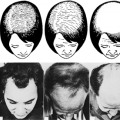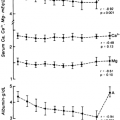SURGICAL APPROACH TO THYROID NODULES
NON-IRRADIATED PATIENTS
Fine-needle aspiration with cytologic examination is heavily relied on when choosing patients for surgery. Generally, any nodule suspected of being a carcinoma should be completely removed, along with surrounding tissue; thus, a total lobectomy (or lobectomy with isthmusectomy) is the initial operation of choice in most patients. A frozen section should be obtained intraoperatively. If the diagnosis of a colloid nodule is made, the surgery is terminated. If a diagnosis of an adenoma is made, then difficulty arises of differentiating, on frozen section,
a follicular adenoma from a follicular carcinoma, or a benign Hürthle cell tumor from a Hürthle cell carcinoma.9 These diagnoses require the careful assessment of cellular morphology as well as capsular and vascular invasion, which are often difficult to evaluate on frozen section analyses. To aid in the diagnosis, enlarged lymph nodes of the central compartment are sampled and a biopsy of the jugular nodes is also performed. If the results are negative, two options exist: (a) stopping the surgery after lobectomy, with the understanding that a second operation may be necessary to complete the thyroidectomy if a carcinoma is ultimately found, or (b) performing a subtotal resection of the contralateral lobe. This latter approach is often used if the patient consents, particularly when a preoperative needle aspiration suggests that a follicular lesion will be encountered intra operatively (see Chap. 39).10
a follicular adenoma from a follicular carcinoma, or a benign Hürthle cell tumor from a Hürthle cell carcinoma.9 These diagnoses require the careful assessment of cellular morphology as well as capsular and vascular invasion, which are often difficult to evaluate on frozen section analyses. To aid in the diagnosis, enlarged lymph nodes of the central compartment are sampled and a biopsy of the jugular nodes is also performed. If the results are negative, two options exist: (a) stopping the surgery after lobectomy, with the understanding that a second operation may be necessary to complete the thyroidectomy if a carcinoma is ultimately found, or (b) performing a subtotal resection of the contralateral lobe. This latter approach is often used if the patient consents, particularly when a preoperative needle aspiration suggests that a follicular lesion will be encountered intra operatively (see Chap. 39).10
Stay updated, free articles. Join our Telegram channel

Full access? Get Clinical Tree





